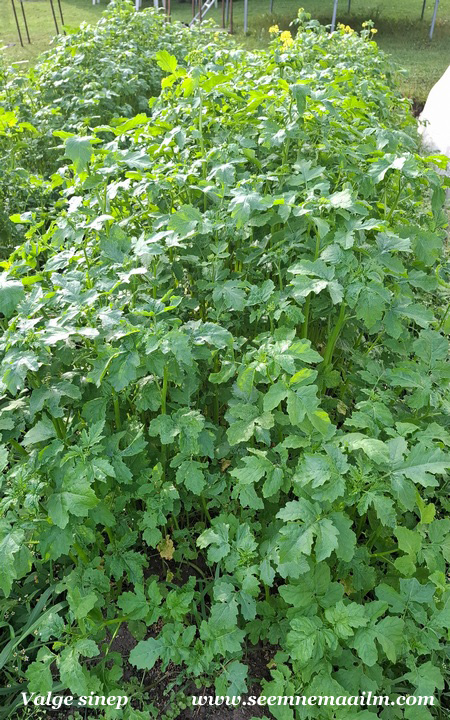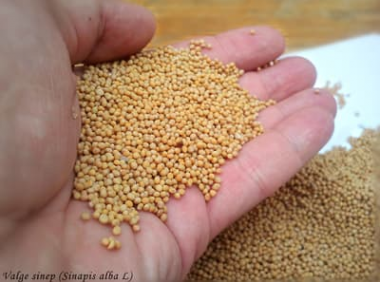Ex Tax: 14.25€
Category: C.
Annual, nectariferous, medicinal, spice plant. Grows best in light clay/sandy loam. Grows fast. Seeds and young leaves (which have a hot taste) are used as food.
Seeds are used to produce mustard powder. Mustard powder can be used with meat and fish dishes as seasoning, leaves – can be used in salads.
Mustard is used to cure atherosclerosis, gastro-intestinal diseases, rheumatism, and eczema.
1,0 g = 145-150 seeds.
White mustard, Yellow mustard or English mustard (Sinapis alba) is an annual cruciferous oil plant that has the ability to release poorly soluble phosphates. It can grow on any soil: pH from very acidic to alkaline.
Seeds germinate at + 3 °C. Seedlings can withstand short-term frosts down to -5 °C.
Mustard rises quickly and grows quickly. The green mass is mowed when the leaves of the plant are fresh, juicy, preferably before mass flowering, because when harvesting at a later date, the leaves will begin to die off and the organic mass will decrease, and the ripened seeds will clog the garden bed.
On average, the period from sowing to embedding of mustard in the soil is 55-70 days (8-10 weeks). It is better to embed it in the soil or dig a little, and by the fall everything will have rotted.
Seeding rate of seeds is 2.5-4.0 g / m2. The depth of planting in the soil is 2-3 cm (sowing is lightly sealed with a rake into the soil).
The next culture is planted no earlier than 3-4 weeks after the planting of the green mass. It is also important the phytosanitary effect of mustard - after planting it, the incidence of plants with such common diseases as late blight, rhizoctonia, tuber scab, fusarium rot, incl. and potatoes.
Sowing of mustard reduces the number of wireworms in the soil, it is also recommended to plow white mustard in late autumn, as a result of disturbed wintering of the wireworm, its death occurs.
To increase the effectiveness of the fight against the wireworm, the seeding rate of mustard is increased to 5.0 g / m2.
In recent years, many farmers refuse to use manure. It is not easy to get it in the right quantities, the labor intensity is high and the price is high. Moreover, the contamination of the site with weeds (in the case of manure application) will force the use of herbicides or exhausting weeding. In this case, green fertilizer will serve as a serious alternative to manure.
Green fertilizer is understood as green manure crops, the fresh plant mass of which is used for fertilization (plowed) to enrich the soil with organic matter.

* What are the benefits of siderates?
Siderata stop the leaching of nutrients outside the root layer, pump nutrients from the deep horizons of the soil into the upper layer, and contribute to the accumulation of humus in the soil, which improves its properties. The more humus is contained in the soil, the lower its thermal conductivity and higher heat capacity, less physical evaporation of water from it, more productive use of soil moisture by cultivated plants. Humus contributes to the intensive development of beneficial soil microflora.
The biomass of the root systems of herbaceous plants plays an important role in enriching the soil with organic residues. When green fertilizer is applied, not only nitrogen, but also other nutrients are accumulated in the soil. Green fertilizer in the soil decomposes much faster than other organic fertilizers rich in fiber. Green fertilizer slightly reduces the acidity of the soil, significantly increases the permeability and moisture capacity of the soil, as a result of which the surface runoff of precipitation decreases and the moisture content in the soil increases sharply. As a green fertilizer (siderates), the following are mainly cultivated: lupine, sweet clover, mustard, alfalfa, phacelia.

White mustard, MUSTARD YELLOW. Bot. syn.: Brassica hirta Moench, Sinapis alba L. subsp. alba.
White mustard is a wonderful green manure. Differs in very fast growth of green mass, is not afraid of frosts. Thanks to it, the structure of the soil improves, beneficial microorganisms multiply, with the help of which the nutrients in the soil become available to plants. Mustard deeply loosens the soil with its roots, and the roots secrete substances that have a detrimental effect on the wireworm, and it escapes from these places. The green mass embedded in the soil is food for microorganisms that process and enrich it. Due to its rapid growth, mustard inhibits the growth of weeds.
Mustard can be sown throughout the garden season: from early spring to early September. In autumn, as soon as flowering begins, they are cut down, crushed, embedded in the soil. Mustard does not tolerate drought well and is demanding on moisture, in dry weather it is watered when the heat of the day subsides, 2-3 hours before sunset. Mustard loves to keep the leaves wet. With a lack of moisture, they coarsen, and the yield of green mass falls.












